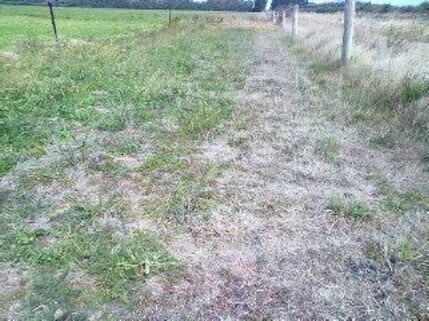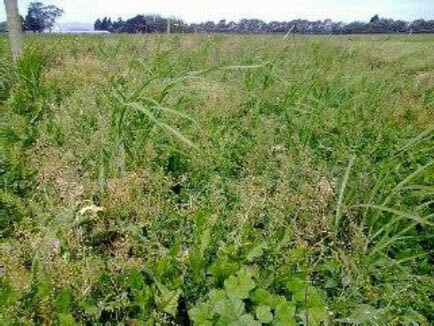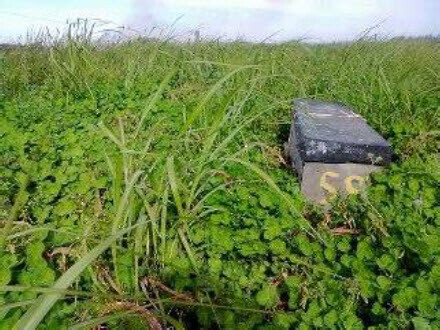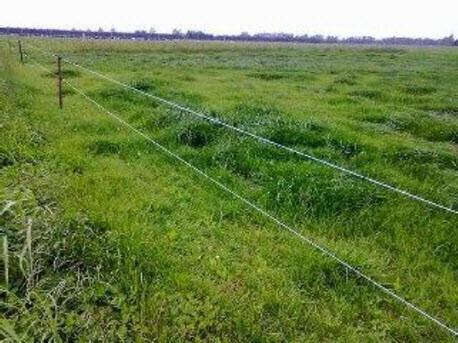Project Update – To March 10, 2013
MxG Plant Survival
With no rain at all recorded at Karetu farm last month, this season has proved to be difficult for establishing MxG plants in areas without irrigation.
Figs. 1 and 2 below from Edwards Road paddock at Springston, where MxG plantings receive some irrigation, illustrate this. Fig. 1 is of the southern fence line, looking east, which only just picks up moisture from the centre pivot. The MxG plants in the row next to the fence receive no water and although they are still alive they are only 20 cm tall. Plant height increases further into the paddock as they start to pick up moisture from the irrigator.
Fig. 1; MxG plantings in Edwards Road paddock along the fence line not reached by the irrigator.
Fig. 2.; MxG plantings in the Edwards Road Paddock looking north down the irrigated fence line.
The plants in the adjacent corner which receive a regular water supply from the centre pivot, as shown in fig. 2, are thriving and many of these are now a metre tall. It will be interesting to see how all MxG plants in this paddock develop and whether the drought-affected plants ever achieve a worthwhile dry matter yield over the next two seasons.
MxG Production and Habitat Creation
At Aylesbury farm, fig. 3, where MxG plants suffered initially when irrigation was not available, the plants are now thriving and are over a metre tall. Irrigation from the Centre pivot started on December 21, 2012 and the plants have achieved this height in just two months. Figs. 2 and 3 also illustrate the new habitat that these plantings have created on what was previously a prairie type landscape. MxG has a vigorous growth habit and thus there is possibly a reduced need for blanket weed control where it is planted. This will be tested by comparing the growth of MxG plants in sprayed and unsprayed areas to establish whether blanket weed removal improves MxG plant growth. As the MxG plant matures light, to the under-story canopy will be reduced in the centre of the plantings, possibly reducing plant diversity. However, MxG above-ground growth is largely absent in the spring and this may allow a diverse plant community to establish within the plantings earlier in the year. One benefit of this will be greater food availability for pollinators. Other ecosytem service benefits related to habitat creation of the plantings being monitored are improved nesting sites for bumble bees and resting areas for skinks. Although these environmental improvements may not impact directly on farm profits, they do send a signal to national and international markets that New Zealand dairy farms aspire to higher levels of functional diversity. The shelter effect on pasture growth is also, of course, important.
Fig. 3; MxG plantings under the centre pivot in paddock 22 at Aylesbury farm. Bumble bee motels have been positioned here to assess if these plantings improve the occupancy rates of these motels on dairy farms. This will aid pollination success in nearby seed and other crops.
Fig. 4; Edge of MxG planting adjacent to paddock 22, Aylesbury Farm, where shelter effect will be measured.
Collection of data
Collection of early baseline data to be used in assessing improvements in pasture production where MxG shelter is established has been taking place. This has involved recording soil nutrient levels, water application rates, soil moisture levels, pasture and MxG production, nutrient and water stress levels. Recording of pasture production from the paddocks where MxG is planted, using the C-dax pasture meter supplied by Agresearch, enables yield maps to be created, as illustrated by the attached file, paddock 21, which is of the pasture heights from paddock 21 at Aylesbury Farm on February 8, 2012. Using this technique will enable a spatial record of pasture growth over time to be created and this will be invaluable in assessing changes due to shelter effect.
This week soil analysis will begin to provide base values to find if there is a shelter effect over the next three years on soil nutrient levels. The following technique will be used:
Study Area
Paddocks have been planted in their north western corner with MxG creating three sampling areas. 1) Where the MxG plants are growing. 2) The area of the paddock immediately influenced by the shelter effect from the MxG. 3) A control area where there is no shelter effect and which is of the same size as 2).
Soil Sampling
Soil sampling will be carried out in each paddock planted with MxG over the next two weeks to get a base value for each area and will be repeated at the same time of year over the next two years. Fifteen cores will be taken along the sampling diagonal coming out from the shelter and these will be homogenised. This will be repeated at an equivalent location in the control area. One sample from this mix will then be sent to Hill Laboratories for analysis.One sample will be kept for in house analysis. This will be repeated for the control area and also 15 cores will be taken from where the MxG is growing.
Soil samples sent to Hill will be fresh soil and will be analysed for the following; pH, CEC, calcium, magnesium, Olsen P, potassium, sulphate sulphur, volume weight.
Soil samples to be analysed in-house will be air-dried at 30 degrees centigrade and stored for analysis later. Drying will continue until the soil weight has stabilised. These will be analysed for total carbon and total nitrogen using a CNS analyser.
Thanks
Thank you to everyone helping me to continue this research, in particular Chris Pullen, Westland Milk Products, for the continued funding and support, Samuel Dennis and his team at Agresearch for allowing me to use their equipment and for assisting in collation of data and creation of yield maps, Mark Williams and his staff at Aylesbury farm for their help and co-operation and Dave Irvine and Marv Pangborne for letting me use their farms.





